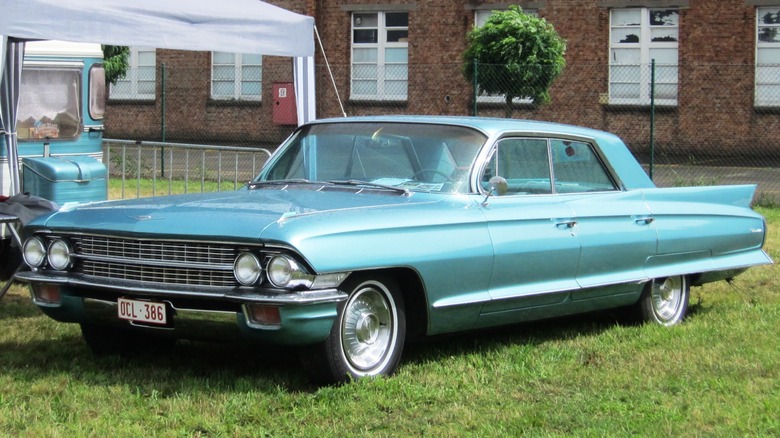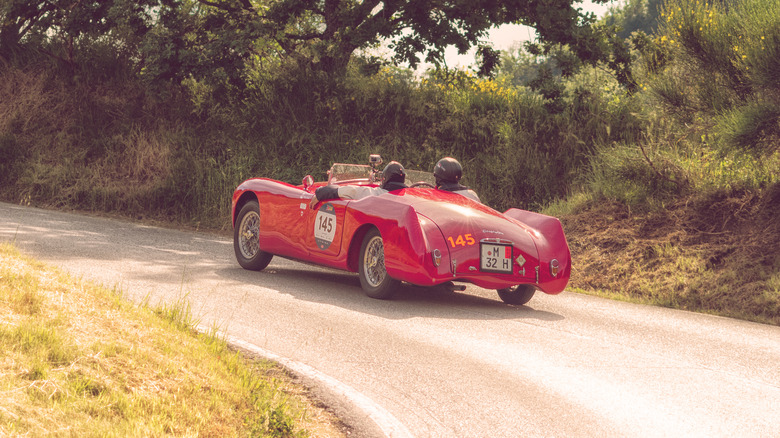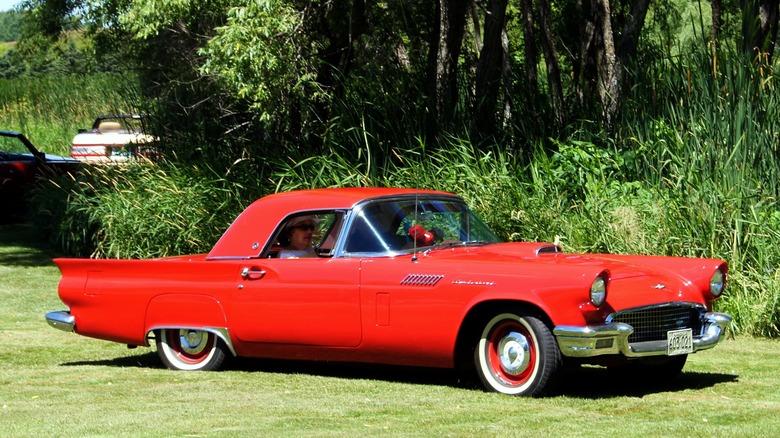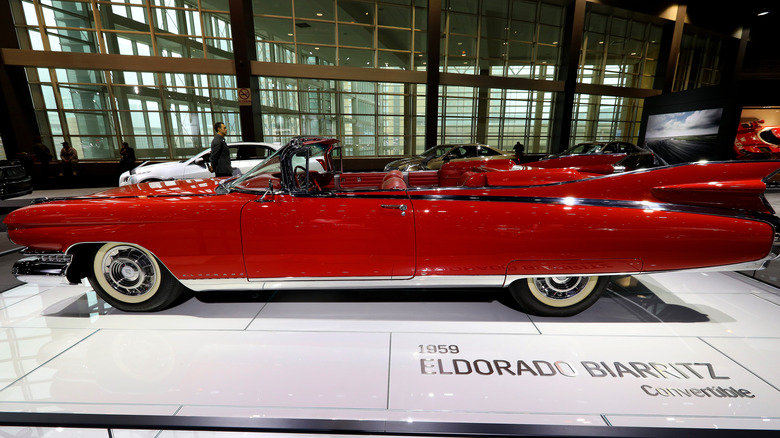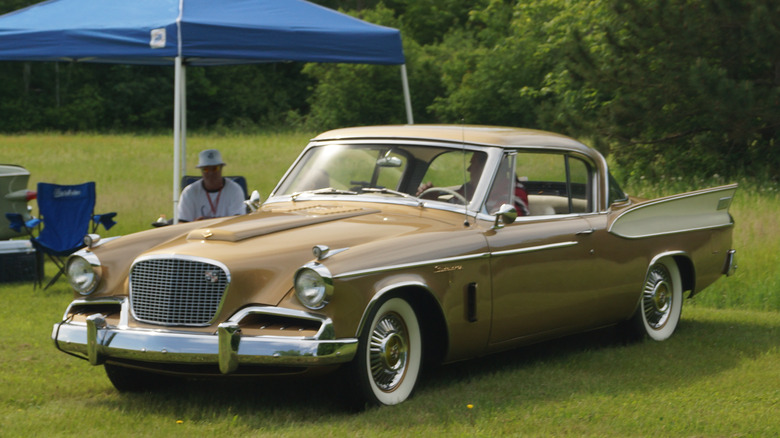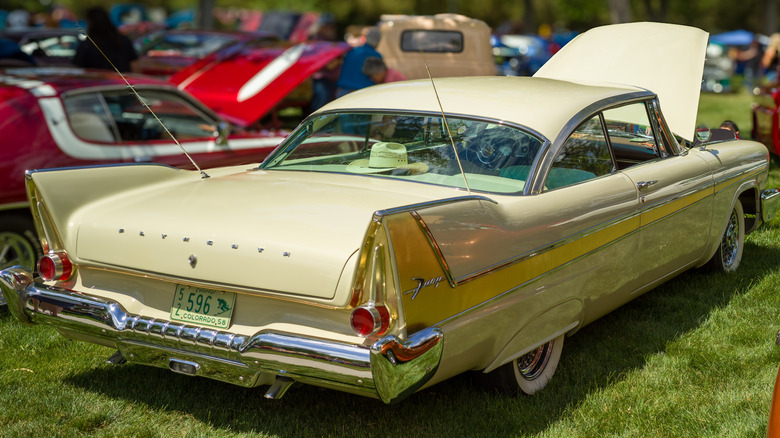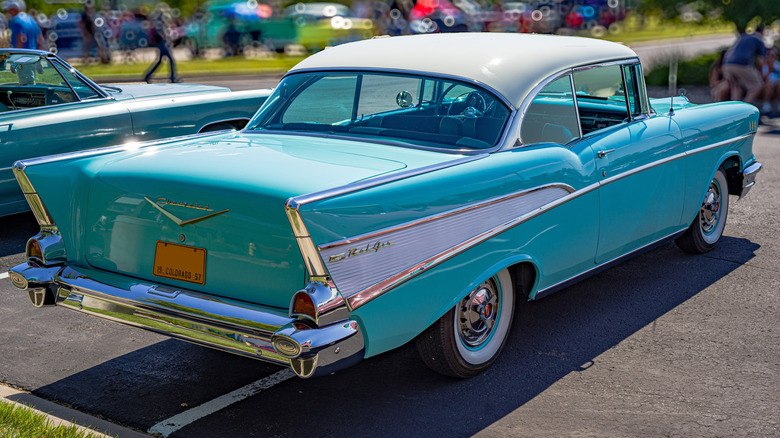6 Of The Coolest Classic Cars With Tailfins
I have been quite fond of classic American cars for most of my life. My grandfather was a race driver in the 1920s and '30s and a civilian mechanic at the Fort Dix Army base outside Pemberton, New Jersey for 50 years after that. He was a huge fan of the Cadillac brand and had an early '60s Sedan DeVille he would occasionally allow me to steer while sitting in his lap. I am comfortable admitting this now because I am certain the statute of limitations for driving without a license is far shorter than the 45 years or so since this transgression.
My gramps also handed down to me a wealth of knowledge about auto repair, and after Hurricane Katrina hit New Orleans in 2005, I took on a project restoring a field of about 200 classic cars. I spent countless hours around and underneath these vehicles, many of which had the sharp tailfins common among many American cars from the 1950s and '60s. The feature wasn't exclusive to domestic models, although it was on the easels of just about every Big Three designer during the Jet Age. These are some of the coolest classic cars with tailfins and why they're so special.
[Featured image by Charles01 via Wikimedia Commons|Cropped and scaled|CC-By 3.0]
The 1947 Cisitalia 202 is a rare beauty
One of the first cars to be graced with large tailfins originated in Italy, although its fins were nowhere near as dramatic as the ones Detroit would draw up a few years later. The 1947 Cisitalia 202 was unveiled at car shows in Milan and Paris and won a design award that same year. The 202 was the first production car built on a tubular chassis, although it saw a limited run of less than 200 units through 1952. That revolutionary frame was topped with an array of bodies crafted by different coachmakers.
About 28 were Spider Mille Miglia Nuvolaris, which were named after racing legend Tazio Nuvolari. During the second lap of the 1946 Brezzi Cup of Turin, the steering wheel of Nuvolari's Cisitalia D46 came off in his hands, but he finished the race by steering with his hands and a wrench. Bruce Rudin, owner of one of the few remaining SMM Nuvolaris, described some of its quirky design features on an episode of the Historical Vehicle Association's "This Car Matters." "Really, nothing else looks like this," Rudin said. "This is almost like a little rocket ship."
You don't have to be a car nut to appreciate a 1950s Thunderbird
The Jet Age peaked in the mid-to-late 1950s, and the first-generation Ford Thunderbird became a symbol of American cruising culture. After Louis Crusoe and George Walker happened upon a Ferrari Barchetta at a Paris car show in 1952, they were inspired to create something similar for Ford. Walker was also responsible for the influential 1949 Ford and the 1950 Lincoln, but he gave neither of those post-war icons the sharp tailfins he attached to the 1955 Thunderbird. The front end was as striking as the rear, with deep headlight wells, a mesh grille, and a beefy chrome front bumper.
In its first 10 days on dealership lots, buyers drove home 3,500 Thunderbirds, and during the first generation that ran from 1955 through 1957, it outsold the Chevy Corvette by a factor of four and a half to one. The tailfins got slightly less prominent with each update and more or less vanished by the late '60s. For its final generation, which started in 2001, Ford went with a retro T-Bird look but eschewed tailfins for a more rounded effect in back.
[Featured image by Greg Gjerdingen via Wikimedia Commons|Cropped and scaled|CC-By 2.0]
The 1959 Cadillac Eldorado Biarritz had enormous tailfins
The 1959 Cadillac Eldorado Biarritz was a wonder to behold, and not just for its gigantic, Batmobile-esque tailfins. It was nearly 19 feet long and barely four and a half feet tall, with a pillarless design and rear wheel skirts. The stunning design was the work of Chuck Jordan, who also gave us the 1958 Corvette and 1968 Opel GT. The sharply raked and curved windshield gave the Biarritz a fighter jet canopy look, and there were bold chrome accents atop the fins and along the upper edges of the body.
The '59 Eldorado Biarritz convertible represents peak tailfin; they are widely regarded as the tallest to ever grace a production car. The model was also expensive. Its sticker price of $7,401 (about $80,000 today) was close to 1.5 times the average American's yearly wage, but buyers got a lot for shelling out that much cash. The 390 cubic-inch V8 put out 345 horsepower, which was enough to get the 5,000-pound behemoth up to 120 miles per hour. The Biarritz also had gas shocks and copious amounts of leather and chrome, and it was the first mass-market Caddy with cruise control.
The Studebaker Golden Hawk looked like a bird spreading its wings
The most popular car in the U.S. in 1956 was the Chevy Corvette — the first of many Corvette generations – but one of the most impressive cars produced at that same time was the stunning Studebaker Golden Hawk. The 1956 model was the first Studebaker to wear tailfins, which were made of fiberglass that first year and steel afterwards. The Golden Hawk was the most powerful and luxurious of four 1956 Hawk models. The Flight Hawk, Power Hawk, and Sky Hawk rounded out the lineup that first year. The 1956 Golden Hawk cost just over $3,000 (around $32,000 today), and Studebaker only made about 4,000 examples that year.
Studebaker was already struggling at that point, so for 1957, the three lower-end Hawks were consolidated into the Silver Hawk, and the Golden Hawk soared on above them. Its fins got a new concave design that year, and for an extra $500, buyers could get the special edition Golden Hawk 400 for added luxury. Studebaker produced the Hawk under the Packard label in 1958 but dropped all of its full-sized models in 1959. A smaller version labeled simply the Hawk returned for 1960 and 1961.
[Featured image by Greg Gjerdingen via Wikimedia Commons|Cropped and scaled|CC-By 2.0]
The 1958 Plymouth Fury became a Hollywood icon
The Plymouth Fury had a longer run than any other car on this list, although tailfins only appeared on the earlier models. The Fury was unveiled at the 1956 Chicago Motor Show, and it went into production with a long list of features befitting its name. Under the hood was a 303 cubic-inch V8 shared by some of the Fury's Mopar cousins. The engine was given performance-enhancing upgrades like domed pistons, a high-lift cam, and dual exhaust. To tame the 240-horsepower powerplant, Plymouth beefed up the suspension and brakes as well.
The carefully designed fins on the 1958 model shown above were advertised as being more than just cosmetic enhancements, with Plymouth claiming they had a positive effect on the car's resistance to crosswinds. The 1958 Fury is also famous for starring as the murderous self-repairing car in the 1983 horror flick "Christine," and the model lived on through 1989.
{Featured image by Button74 via Wikimedia Commons|Cropped and scaled|CC-By 4.0]
The 1957 Chevy Bel Air is an enduring classic
If you frequently attend car shows in the United States, you have most likely come across more than a few 1957 Chevy Bel Airs. This model is so popular it has become known as simply the '57 Chevy, and it's instantly recognizable for its prominent tailfins and generous use of chrome. The Bel Air was at the very end of its second generation in 1957, and Chevy sold hundreds of thousands. The rarest version is the two-door Nomad wagon, which only saw a run of about 8,500 units.
The fins were ditched in 1958 in favor of sculpted rear quarters, but they returned for the fourth generation in 1959 with sharper points and a more horizontal orientation. Over the next 16 years, the fins were replaced by more subtle ridges and bulges, but the iconic '57 model lives on in the garages of enthusiasts and in pop culture at large. It has appeared in hundreds of movies and TV episodes, from the classic films "American Graffiti" and "The Outsiders" to modern TV shows like "Curb Your Enthusiasm" and "The Simpsons."
[Featured image by Button74 via Wikimedia Commons|Cropped and scaled|CC-By 4.0]
